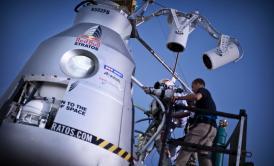UPDATE: Felix Baumgartner became the first person to beak the sound barrier without traveling inside a craft Sunday. During his jump from more than 24 miles up, Baumgartner hit Mach 1.24, or 833.9 mph, according to preliminary data, reports the Associated Press. “When I was standing there on top of the world, you become so humble, you do not think about breaking records anymore, you do not think about gaining scientific data,” Baumgartner said after the jump. “The only thing you want is to come back alive.”
Watch the jump:
Sunday, 14 October at 3:15 p.m..: Felix Baumgartner made it. He landed safely on the ground after a 24-mile jump from the stratosphere. It was a record-breaking event, although it remains unclear whether the Austrian daredevil had managed to break the speed of sound during his free fall, which was one of the key goals of the mission, reports the Associated Press.
Nine minutes after he jumped from the 11-by-8-foot capsule at 128,097 feet, making it the highest skydive on record, he was back on New Mexico soil. Baumgartner pierced the atmosphere at speeds as high as 700 miles per hour, which would suggest that the speed of sound was broken, although there was no confirmation yet, notes Reuters. Nearly 7.3 million were watching the “live” YouTube stream of the event right before Baumgartner jumped. NASA appeared to be one of those keeping close track of the event. NASA sent out a tweet congratulating Baumgartner and his team “on a record-breaking leap from the edge of space!”
Sunday, 14 October at 1:10 p.m.: Felix Baumgartner, an Austrian professional daredevil, was finally able to stop postponing his bid to become the first skydiver to break the sound barrier as he began his ascent to the stratosphere on Sunday morning. Baumgartner took off from the New Mexico desert in a huge helium balloon that carried a pressurized capsule at 9:30 a.m. (11:30 a.m. EDT). His 23-mile ascent should take around three hours while the descent should last up to 20 minutes, reports Reuters. Some 30 cameras recorded the event. You can follow Baumgartner’s jump through what is being billed as a “live” stream below. The Associated Press notes the video has a 20-second delay in case of an accident.
Baumgartner is trying to break a 52-year record held by Joe Kittinger, an adviser to his project, who jumped from a balloon flying at 102,800 feet and fell for 4 minutes and 36 seconds before opening his parachute in 1960. Baumgartner is now attempting a jump from 120,000 feet and free fall for 5 minutes and 35 seconds. About 30 seconds into the free fall, Baumgartner should be moving faster than the speed of sound, around 690 mph. There are more than 300 people in the “NASA-style mission control” that is providing support for Baumgartner, including 70 people who have been working on the project for five years, notes the New York Times.
Follow the jump below:
While it may seem like a vanity project aimed at simply breaking records, all the engineers and scientists working on the effort say the data they will collect during the jump will be able to help pilots and astronauts in the future if they have to exit their crafts. Also, assuming Baumgartner’s high-tech spacesuit works as intended and protects him from the shock waves of breaking the sound barrier, it could lead to NASA certifying a new generation of spacesuits, points out the AP.
Baumgartner says this will be his last jump as he has plans to settle down with his girlfriend when it’s all over.
